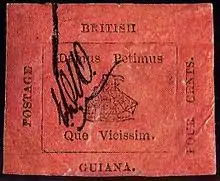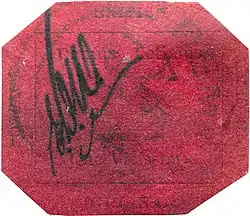British Guiana 1c magenta
The British Guiana 1c magenta is regarded by many philatelists as the world's most famous rare stamp.[3][4] It was issued in limited numbers in British Guiana (now Guyana) in 1856, and only one specimen is now known to exist. It is the only major postage stamp ever issued that is not represented in Britain's Royal Philatelic Collection.[5]

| British Guiana 1c magenta | |
|---|---|
 | |
| Country of production | British Guiana (now Guyana) |
| Location of production | Georgetown |
| Date of production | 1856 |
| Nature of rarity | Very limited printing |
| No. in existence | 1 |
| Face value | 1c |
| Estimated value | US$9,480,000 (last sale, 17 June 2014, including buyer's premium)[1][2] |
It is imperforate, printed in black on magenta paper, and it features a sailing ship along with the colony's Latin motto "Damus Petimus Que Vicissim" (We give and expect in return) in the middle. Four thin lines frame the ship. The stamp's country of issue and value in small black upper case lettering in turn surround the frame. With its US$9,480,000 sale on 17 June 2014[1][2] to Stuart Weitzman, this item has broken the world record for a single stamp auction price each of the last four times it has been sold.[6]
Background
The 1c magenta was part of a series of three definitive stamps issued in 1856 and was intended for use on local newspapers. The other two stamps, a 4c magenta and 4c blue, were intended for letter postage. The issue came about through mischance. An anticipated delivery of stamps by ship did not arrive so the local postmaster, E.T.E. Dalton, authorised printers Joseph Baum and William Dallas, who were the publishers of the Official Gazette newspaper in Georgetown, to print an emergency issue of three stamps. Dalton gave some specifications about the design, but the printer chose to add a ship image of their own design to the stamps. Dalton was not pleased with the end result, and as a safeguard against forgery ordered that all correspondence bearing the stamps be autographed by a post office clerk. This particular stamp was initialled E.D.W. by the clerk E.D. Wight.
Description and history
Only one copy of the 1c stamp is known to exist. It is in used condition and has been cut in an octagonal shape. A signature, in accordance with Dalton's policy, can be seen on the left-hand side, along with a heavy postmark.
It was discovered in 1873 by a 12-year-old Scottish schoolboy, Louis Vernon Vaughan, in the Guyanese county of Demerara (whose postmark the stamp bears), amongst his uncle's letters. There was no record of it in his stamp catalogue, so he sold it some weeks later for six shillings[3] to a local collector, Neil Ross McKinnon. In 1878 McKinnon's collection was sold to a Liverpool stamp dealer, Thomas Ridpath, for £120.[7] Shortly afterwards, in the same year, Thomas Ridpath sold the 1c to Philipp von Ferrary for about £150.[7] His massive stamp collection was willed to a Berlin museum but following Ferrary's death in 1917 the entire collection was taken by France as war reparations following the end of World War I.[8]
.jpg.webp)
Arthur Hind bought the stamp during a series of fourteen auctions in 1922 for over $36,000 (reportedly outbidding three kings, including George V); on 6 April 1922, sale 3, lot 295, the stamp sold for 300,000 franc + 17½% tax (@48 frs. to £1 it was £7,343).[7] On 30 October 1935 it was offered for sale at Harmer Rooke & Co auction 2704, lot 26, where a bid of £7,500 was received from Percival Loines Pemberton. However, the lot was withdrawn and returned to Mrs. Scala (formerly Mrs. Hind).[7] In 1940, she offered it for private sale through the philately department of Macy's department store in New York City. It was purchased for $40,000 by Fred "Poss" Small, an Australian-born engineer from Florida, who had wanted to own the stamp since he first heard about it as a boy.[9] In acquiring it, Small completed a full set of stamps from British Guiana. In 1970, Small auctioned his entire stamp collection (estimated to be worth $750,000), and the 1c stamp was acquired by a syndicate of Pennsylvanian investors, headed by Irwin Weinberg, who paid $280,000 for it and spent much of the decade exhibiting it in a worldwide tour. John E. du Pont bought it for $935,000 in 1980,[3][6] setting the world's record for a single stamp price again.[6] Subsequently, it was believed to have been locked in a bank vault while its owner was in prison.[10] Du Pont died while still incarcerated on 9 December 2010; 80 percent of the proceeds from the auction went to Bulgarian Valentin Yordanov, a retired Bulgarian wrestler, to whom Du Pont left the majority of his estate.[11]
The stamp was sold from the DuPont estate on 17 June 2014 at a Sotheby's New York auction, sale number N09154, for $9,480,000, including buyer's premium.[1][2] It took only two minutes to sell to an anonymous bidder, and was the fourth time the stamp had broken the world's record for a single-stamp bid; this time, the sale broke the 1996 record of $2,300,000 for the Treskilling Yellow, an 1855 Swedish stamp.[6] The purchaser has since identified himself as shoe designer and businessman Stuart Weitzman, who collected stamps as a child.[12]
Controversies
At one point, it was suggested that the 1c stamp was merely a "doctored" copy of the magenta 4c stamp of the same series, a stamp very similar to the 1c stamp in appearance. These claims were disproven.[13]
In the 1920s a rumour developed that a second copy of the stamp had been discovered by then-owner, Arthur Hind, who quietly purchased the supposed second copy to subsequently destroy it. The rumour has not been substantiated.[14]
In 1999, a second 1c stamp was claimed to have been discovered in Bremen, Germany. The stamp was owned by Peter Winter, who is widely known for producing many forgeries of classic philatelic items,[15] printed as facsimiles on modern paper. The stamp was twice examined and found to be a fake by the Royal Philatelic Society London. In their opinion, this specimen is an altered 4c magenta stamp.[14][16]
Public display
The stamp was displayed at the 1939 New York World's Fair, the 1956 Fifth International Philatelic Exhibition (FIPEX) in the New York Coliseum, Australia in 1963, New York's 1964 Centenary International Stamp exhibition (CIPEX), London in 1965, and Toronto's Canadian Philatelic Exhibition (CAPEX) in 1978.[17]
In November 2014, the National Postal Museum of the Smithsonian Institution announced that the then-anonymous owner of the stamp had agreed to display it at the museum in Washington, D.C., beginning 4 June 2015 and running through 2 December 2018.[18] Next to the Postal Museum exhibit is a copy of a Donald Duck comic book, The Gilded Man, (OS 422) from 1952 whose central plot element revolves around Donald and his nephews, Huey, Louie and Dewey, going to British Guiana to try to find another copy of the stamp. The comic is written and drawn by Carl Barks.[19]
The stamp was exhibited in the Court of Honor at World Stamp Show-NY 2016 in New York City from 28 May to 3 June 2016.[20][21]
See also
| Wikimedia Commons has media related to British Guiana 1c magenta. |
- List of postage stamps
- Finbar Kenny, manager of Macy's stamp department, who arranged the sale of the stamp in 1940
- Robert A. Siegel, who auctioned the stamp twice, in 1970 and 1980
References
- "The British Guiana". Sotheby's. 17 June 2014. Archived from the original on 3 July 2015. Retrieved 19 July 2014.
- "The British Guiana" (PDF). Sotheby's. 17 June 2014. Archived (PDF) from the original on 24 September 2015. Retrieved 19 July 2014.
- Carlton, R. Scott (1997). The international encyclopaedic dictionary of philatelics. Krause Publications. pp. 36–37. ISBN 0-87341-448-9.
- "Rare stamp sets auction record". 18 June 2014. Archived from the original on 25 November 2018. Retrieved 21 June 2018 – via www.bbc.co.uk.
- Feinberg, Ashley (1 March 2014). "Why This Red Smudge Is The Most Valuable Stamp In The World". Gizmodo Australia. Archived from the original on 31 October 2014. Retrieved 8 December 2014.
- "Rare British Guiana stamp sets record at New York auction". BBC News. 17 June 2014. Archived from the original on 18 June 2014. Retrieved 18 June 2014.
- Williams, L. N. and M. (1946). Famous Stamps. Chambers. p. 26.
- "The One and Only British Guiana 1c Magenta: Part I". 29 August 2018. Archived from the original on 9 September 2018. Retrieved 9 September 2018 – via oldlouis.com.
- McGann, George (8 April 1970). "What did it feel like to own the most valuable piece of paper in the world?". Australian Women's Weekly. pp. 2–3.
- Rachlin, Harvey (1996). Lucy's Bones, Sacred Stones and Einstein's Brain. Henry Holt & Company. ISBN 0-8050-6406-0.
- Brown, Robin (18 June 2014). "Du Pont stamp sells for record $9.5 million". The News Journal. Archived from the original on 18 December 2014. Retrieved 14 February 2019.
- "Stuart Weitzman to Display Rare Stamp That Fulfilled Boyhood Dream", New York Times, 4 June 2015, archived from the original on 11 July 2017, retrieved 1 March 2017
- "Part 5: The Story of the World's Most Famous Stamp from 1892 to 1922". Sotheby's. Archived from the original on 24 September 2015. Retrieved 8 December 2014.
- "British Guiana: the rarest stamp in the world?". Stamp Magazine. Archived from the original on 29 June 2016. Retrieved 8 December 2014.
- Oswald, Sheryll (28 July 2001). "Peter Winter and the modern German forgeries on eBay". Archived from the original on 23 February 2015. Retrieved 8 December 2014.
- Pearson, Patrick (May 2000). "British Guiana Four Cent and One Cent of 1856". The London Philatelist (1275). pp. 108–120.
- Barron, James (2017). The One-Cent Magenta, Inside the Quest to Own the Most Valuable Stamp in the World. Chapel Hill: Algonquin Books. pp. 151–153, 166–167, 183. ISBN 9781616205188.
- "British Guiana One-Cent Magenta: The World's Most Famous Stamp". Smithsonian National Postal Museum. Archived from the original on 6 September 2018. Retrieved 6 November 2018.
- Barrier, Michael (1982). Carl Barks and the Art of the Comic Book. M. Lilien. ISBN 978-0960765201.
- "Unique British Guiana 1¢ Magenta Stamp Sells". Auctions. Linn's Stamp News. 17 June 2014. Archived from the original on 13 January 2015. Retrieved 12 December 2017.
- "British Guiana 1¢ Magenta to be displayed at World Stamp Show – NY 2016". World Stamps. Linn's Stamp News. 24 September 2015. Archived from the original on 13 December 2017. Retrieved 12 December 2017.